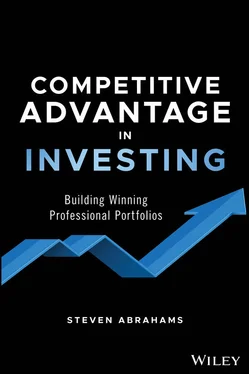Sharpe's approach underscored the importance of financial leverage. The ability of investors to borrow money and reinvest in riskier assets plays a critical role in making markets efficient. When investors can borrow and reinvest easily, the riskiest investments have to compete against returns available from a leveraged position in a safer portfolio of assets. When investors cannot borrow and reinvest easily, the riskiest investments can get away with providing returns below a fair rate. Investors who need an above-average rate of return have to invest in assets that provide less-than-fair compensation. That might hurt the individuals, banks, insurers, pension funds, and others that might need high rates of return to cover some of their greatest expected future expenses. This belies the common perception that financial leverage only adds risk to an investment portfolio without adding sufficient return. In Sharpe's world, it is just the opposite. A portfolio unable to use leverage or borrow to invest will likely buy risky assets nevertheless but get underpaid for taking the risk.
Sharpe also gave the market a yardstick for measuring the fair price of an equity investment in a company. The fair price of equity had always been elusive. Investors hand over their money and then wait for dividends, a rise in the value of their equity stake, or both. By making the case that the value of an investment depended on its expected performance compared to the market, investors had a way of setting fair price. Equity investments with roughly the same risk as the overall equity market—in other words, investments with a beta of 1—should provide the same rate of return as the overall market. If the market had an expected excess return of 8%, for example, equity with a beta of 1 should also provide a combination of dividends and price appreciation of 8%. Similarly, equity with a beta of 0.5, or half the risk of the overall market, should provide returns of 4%. And equity with a beta of 1.5 should provide returns of 12%. The cost of equity depended on risk relative to the market overall. That gave investors and companies a way to measure and compare the cost of debt and equity.
Sharpe also put the performance of asset managers in a spotlight, one that left many a little pale. Investors who entrusted their capital to an asset manager could now compare periodic returns in their portfolio to periodic returns in the market overall. If the manager invested in equity, the investor could compare the manager's equity returns to an equity market index such as the S&P 500. If the manager invested in bonds, the investor could compare returns to a bond market index. If a manager invested in real estate, the investor could compare returns to a real estate index. The comparison provided an alpha, beta, and a measure of idiosyncratic risk in the manager's portfolio. This simple approach has transformed asset management.
One thing investors quickly realized is that an asset manager could deliver an above-market return simply by taking on above-market risk, or deliver a below-market return by taking below-market risk. Absolute return alone didn't indicate either a good or bad job. It could all depend on beta. Once the investor measured a manager's beta, it became clearer whether the manager was adding any value beyond the portfolio's level of market risk.
The measure of value showed up in the manager's alpha, and one revolutionary implication of Sharpe's approach was that investment managers may not have any sustainable competitive advantage in creating alpha. Alpha for a portfolio that just invested in the market basket of assets would simply be the average riskless rate over the investment period. If a manager showed an alpha higher than this average riskless rate, the manager had added value above and beyond the simple returns from beta or systematic market risk. If the manager's alpha came in below, then the manager had destroyed value. Across the entire market, however, the average manager would neither add nor destroy value. The average alpha across the market always had to equal the average riskless rate. This challenged the very value of asset management itself. Not long after Sharpe published, Burton Malkiel, an economist at Princeton, wrote A Random Walk Down Wall Street, arguing that few if any managers can consistently beat the market (Malkiel, 1973). And decades of research since Sharpe first published have tended to show that few asset managers consistently deliver alpha across long periods after subtracting their fees. In Sharpe's world, no manager can beat the market. No manager can get a sustainable competitive advantage.
A Theory that Changed Investing
Sharpe's powerful simplification of investing into the capital market line and the yardsticks of alpha and beta changed investing. By the end of the 1970s, John Vogel had launched the first passive equity market index fund at Vanguard to enable investors to have an easy way to own the market portfolio. The evaluation of managers by alpha, beta, and other measures had begun.
As research into the implications of Sharpe's framework blossomed, however, a few odd results started turning up. Some of the predictions about asset returns made by CAPM did not seem to fit actual data. This is the essence of any scientific approach: theory may be beautiful, intuitive, or appealing, but it must explain the real world. Theory without confirmation in data risks becoming fiction. Ultimately, one professor at the University of Chicago and one at Dartmouth would make a decades-long project of unveiling considerable flaws in Sharpe's beautiful theory.
1 1
3 The Counsel of Critics
Putting Theory to the Test
The capital asset pricing model comes along and creates a new paradigm in investing. It comes with simplicity, rigor, and direct application to practical matters. It simplifies investing into a choice between cash or other riskless assets and the market portfolio. The infinite menu of investments becomes manageable. It helps measure the performance of Wall Street's investment managers. The model even helps companies set the cost of equity capital by scaling the return on the market portfolio up or down depending on the beta of a company's stock. It quickly becomes the orthodoxy of pure finance and, over time, the most if not the only model of portfolio investing taught in business schools. But over time, the model also proves to be flawed.
All good theory needs testing in the real world, and the best tests take predictions made by theory and look for evidence in data. Theory proves itself through prediction and confirmation in observable results. The testing of CAPM started almost immediately, and the results immediately signaled that something was amiss.
To start, CAPM predicted that the return on any asset begins with the riskless return and then adds a multiple of the excess return on the market portfolio of risky assets:

Michael Jensen (1967), then at the Harvard Business School, noted that if investors stripped out the riskless rate from the periodic return on each asset, then CAPM predicted the only thing left would be the multiple of the excess return on the market portfolio:


In other words, the return on any investment above and beyond the riskless rate was simply the excess return of the market portfolio scaled up or down by a multiplier,  . That pointed to a CAPM prediction that investors could test directly:
. That pointed to a CAPM prediction that investors could test directly:
Читать дальше




 . That pointed to a CAPM prediction that investors could test directly:
. That pointed to a CAPM prediction that investors could test directly:










